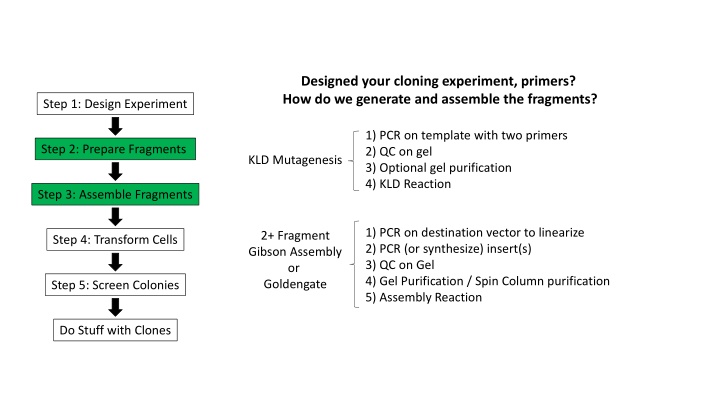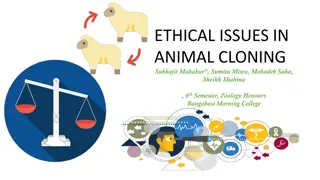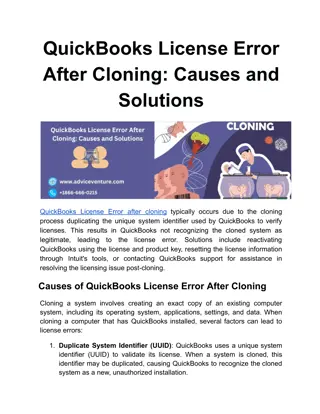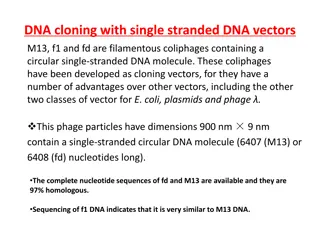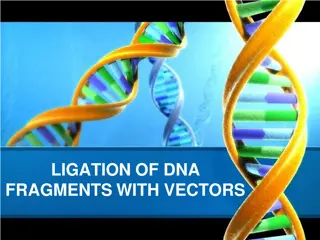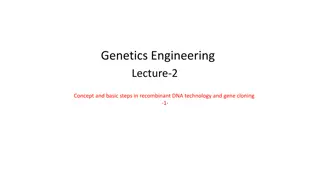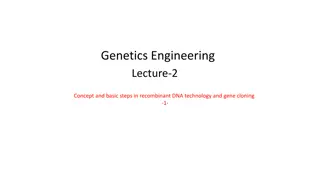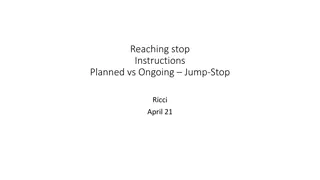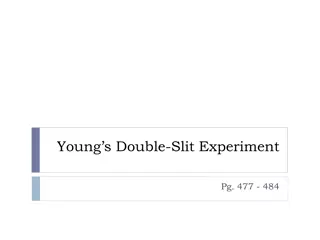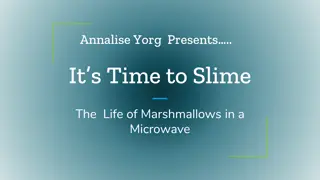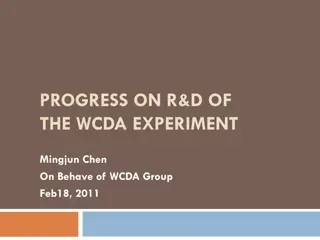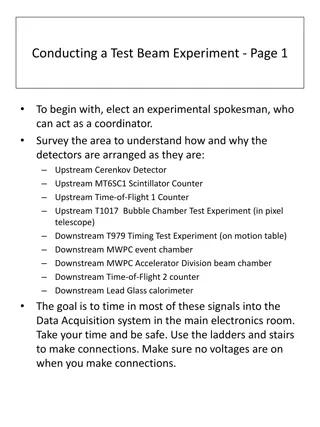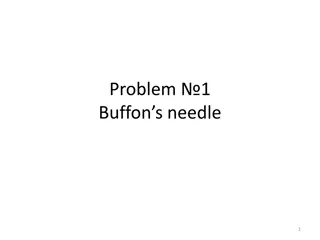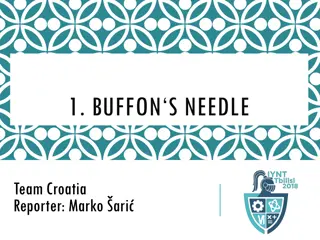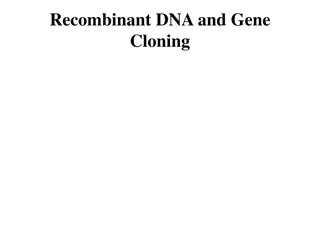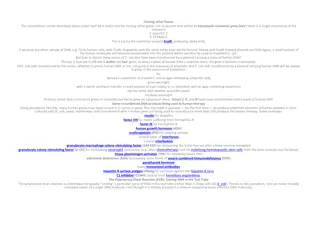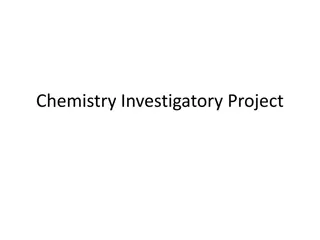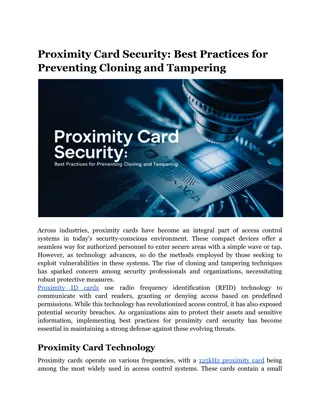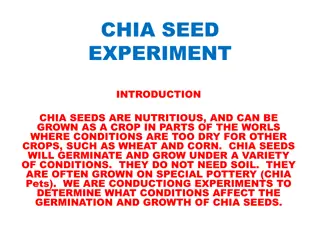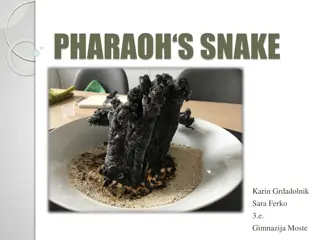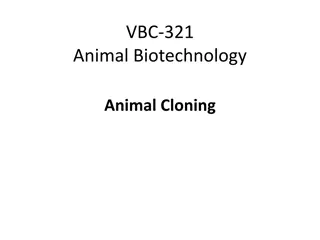Cloning Experiment Overview and Procedures
The cloning experiment involves designing primers, generating and assembling fragments through PCR, gel purification, and KLD reaction. Further steps include fragment preparation, assembly, cell transformation, colony screening, and working with clones. Detailed instructions for KLD mutagenesis, QC procedures, and Gibson/Goldengate fragment preparation are provided.
Download Presentation

Please find below an Image/Link to download the presentation.
The content on the website is provided AS IS for your information and personal use only. It may not be sold, licensed, or shared on other websites without obtaining consent from the author.If you encounter any issues during the download, it is possible that the publisher has removed the file from their server.
You are allowed to download the files provided on this website for personal or commercial use, subject to the condition that they are used lawfully. All files are the property of their respective owners.
The content on the website is provided AS IS for your information and personal use only. It may not be sold, licensed, or shared on other websites without obtaining consent from the author.
E N D
Presentation Transcript
Designed your cloning experiment, primers? How do we generate and assemble the fragments? Step 1: Design Experiment 1) PCR on template with two primers 2) QC on gel 3) Optional gel purification 4) KLD Reaction Step 2: Prepare Fragments KLD Mutagenesis Step 3: Assemble Fragments 1) PCR on destination vector to linearize 2) PCR (or synthesize) insert(s) 3) QC on Gel 4) Gel Purification / Spin Column purification 5) Assembly Reaction 2+ Fragment Gibson Assembly or Goldengate Step 4: Transform Cells Step 5: Screen Colonies Do Stuff with Clones
KLD Mutagenesis Fragment Prep 1) Prepare PCR with: Highly accurate polymerase (Q5 or equivalent) Long plasmids? GC Enhancer Buffer VERY useful LOW template amount (0.1 to 0.5 ng plasmid/25 uL PCR reaction) -> Make it easier for the DpnI Initial Denaturation: 95 C for 90 seconds 2) Thermocycling settings: 30 Cycles of: 95 C for 30 seconds 50 67 C for 30 seconds 72 C for 30 seconds/kb Weak band? Bump up to 35-40 cycles More cycles -> More non-specific bands Have a gradient PCR machine? 4-6 reactions from 55-67 C No gradient PCR? Start at 59 C and pray Final Extension: 72 C for 2X Cycling Extension Time END LET THE PCR MACHINE COAST TO ROOM TEMP! PCR products can survive for DAYS at RT Your thermocycler is not a refrigerator!
KLD Mutagenesis QC 1) Run 5-8uL of PCR product on a 1% agarose 2) Do I have a product of expected size? (*) 3) Is the PCR product pretty clean? Annealing Gradient Annealing Gradient * * Noice and clean? Expected product + other bands? Optimize PCR Optimize Primers YOLO (Screen more colonies) Pool Samples Gel Purify No cleanup needed (usually) KLD Reaction KLD Reaction
KLD Reaction - - NEB s KLD mix -> Nice, but $$$ Homemade KLD mix -> Works great, assemble yourself (Thank you msr2009/reddit for recipe) 1ul PCR product or gel purified band (5-10ng total should do it) 1ul 10X T4 DNA ligase buffer 1ul T4 PNK 1ul T4 DNA ligase 1ul DpnI 5ul H2O ---------------------- 10uL total Incubate at RT for 1 hour, transform 1uL of reaction/100uL comp. cells - That s it? If you ve got a decent PCR product KLD reactions are pretty smooth.
Gibson/Goldengate 2+ Fragment prep 1) Prepare PCR with: Highly accurate polymerase (Q5 or equivalent) Long fragments? GC Enhancer Buffer VERY useful Shorter fragments? <2-3kb? May or may not need GC enhancer -> Lowers accuracy (a bit) LOW template amount (0.1 to 0.5 ng/25 uL PCR reaction) -> Make it easier for the DpnI Initial Denaturation: 95 C for 90 seconds 2) Thermocycling settings: 30-40 Cycles of: 95 C for 30 seconds 50 67 C for 30 seconds 72 C for 30 seconds/kb Have a gradient PCR machine? 4-12 reactions from 55-67 C No gradient PCR? Start at 59 C and pray Final Extension: 72 C for 2X Cycling Extension Time END LET THE PCR MACHINE COAST TO ROOM TEMP! PCR products can survive for DAYS at RT Your thermocycler is not a refrigerator!
Gibson/Goldengate 2+ Fragment QC 1) Run 5-8uL of PCR product on a 1% agarose 2) Do I have a product of expected size? (*) 3) Is the PCR product pretty clean? Annealing Gradient * * * * Noice and clean? Expected product + Nonspecific? Optimize PCR Optimize Primers DpnI treatment DpnI treatment Gel Extraction Protocol Less Risk + Slower NO Riskier + Faster Gel Extraction Protocol PCR Cleanup Column CLEANUP Assembly DO YOU FEEL LUCKY Assembly
Gibson Assembly - - - - - - - Determine concentration of all fragments with spectrophotometer Calculate fmol/uL for all fragments (NEB Biocalculator -> dsDNA Mass to Moles) 1 vector fragment, 1 insert? 1:3 molar ratio 1 vector fragment, 1 small insert (100-500bp)? 1:5 to 1:10 ratio 1 vector, 2 or more fragments? 1:1:1 etc ratio Shoot for 200fmol of all fragments combined, 50fmol is grim but doable, 400+ fmol for 3+ fragment assemblies Which mix to use? 1-4 Fragments? 1-3 Fragments? 2X Gibson Assembly Master Mix 405 l Isothermal Start Mix 25 l 1M DTT 20 l 25mM dNTPs 50 l NAD+ (NEB Cat. B9007S) 1 l T5 exonuclease (NEB Cat. M0363S) 31.25 l Phusion High Fidelity DNA Polymerse (NEB Cat. M0530S) 250 l Taq Ligase (NEB Cat. M0208S) 467.75 l H2O Mix by pipetting gently. Make 100 l aliquots. 1-4 Fragments? 1-5 Fragments? 5X TEDA Cloning Mix (1 mL) 500 mM Tris HCl pH 7.5 (0.5 mL of 1M stock) 50 mM MgCl2 (50 uL of 1M stock) 50 mM dithiothreitol (100 uL of 0.5M stock) 0.25 g of PEG 8000 (May need gentle heat) 1 l of 10 U/ l T5 exonuclease (NEB) Commercial Gibson Mix (NEB or Other brands) Commercial Hi-fi Mix (NEB) Isothermal Start Mix 1.5g PEG8000 3ml 1M Tris-HCl, pH 8.0 150 l 2M MgCl2 Put on tube rotator until PEG is in solution Combine fragments + mastermix in 10-20uL volume Combine fragments + mastermix in 10-20uL volume Combine fragments + mastermix in 10-20uL volume Recipe/Optimization by Ethan Ford -> Ethanomics blog 30C for 40 minutes 50C for 60 minutes 50C for 60 minutes Combine fragments + mastermix in 10-20uL volume 50C for 60 minutes - Mix chosen depends on number of fragments to assemble and budget. Gibson/Hifi mastermix has a notoriously short shelf life! Even at -80C
Golden Gate Assembly - - - - - - Determine concentration of all fragments with spectrophotometer Calculate fmol/uL for all fragments (NEB Biocalculator -> dsDNA Mass to Moles) 1 vector fragment, 1 insert? 1:2 molar ratio 1 vector, 2 or more fragments? 1:2:2 etc ratio Equimolar ratios can also be used BsaI-HFv2 works best at 37 C, T4 Ligase at 16 C, so we cycle the reaction 1 Cycle of: 37 C for 3 minutes 16 C for 6 minutes 25 Cycles of: 37 C for 1.5 minutes 16 C for 3 minutes 10X T4 DNA Ligase Buffer Vector (50 fmol) Insert(s) (100 fmol each) T4 DNA Ligase BsaI-HFv2 dH2O Total 2 uL X uL X uL 0.5 uL 0.5 uL X uL 1 Cycle of: 37 C for 6 minutes 80 C for 10 minutes END 20 uL Reaction - - - Other restriction enzymes may be substituted for BsaI-HFv2, some require a 42 C incubation temperature Cycling increases efficiency of multi-fragment assemblies, 2 fragment assemblies may not need cycling (but doesn t hurt) Cycling program can be as complex or simple as you want
Gel Purification Protocol 1) Pool PCR products from multiple reactions - Anywhere from 4-12 reactions - Can I gel purify 1 reaction? Sure, but expect low yield good luck downstream! 2) Add 0.5-1uL of DpnI to pooled reaction per 100 uL of PCR product -> 37 C for 1+ hours (Overnight is fine) 3) Desalt/concentrate digested PCR product with PCR Cleanup Protocol (Silica column cheat sheet) - Just concentrate PCR product and run on gel? -> Smear on agarose due to concentrated salt/buffer - Large volume difficult to load on low-melt agarose gel -> Diluted in gel volume - Silica column desalts AND concentrates pooled PCR product (Better than G50 resin, trust) 4) Elute in 35-50 uL if you don t have a Centrivap, elute in 100 uL and concentrate to 35 uL if you do 5) Load onto low-melt agarose with a blue-light reactive dye - Ethidium bromide + UV -> Damages DNA -> Longer DNA fragments = More damage/time - Don t have a gel comb that will fit 35-50uL? Tape a few lanes together MVP <3 I luv u 6) Cut out desired band under blue light and purify with silica column (Silica column cheat sheet) 7) Elute in 35-50 uL if you don t have a Centrivap, elute in 100 uL and concentrate to 35-50 uL if you do 8) Determine concentration of fragments with spectrophotometer: - Less than 10ng/uL? Dicey, but doable. Consider additional PCR reactions to bulk up concentration - 10-30ng/uL? Good enough depending on size of fragments - 30-100ng/uL? Comfortable amount for most applications - >100ng/uL?You re laughing! Enough for repeats!
Assembly Controls? - - More controls -> Easier to troubleshoot when things go wrong Difficult assembly? Do more controls Tests for: - DpnI template degradation Same reaction WITHOUT ligase KLD Mutagenesis 2+ Fragment Gibson Assembly or Goldengate Tests for: DpnI template degradation Self annealing of fragments Each Fragment by itself + Gibson assembly mix - - E.g. Vector alone, Fragment 1 alone Tests for: Bad plates Bad antibiotics - Bad cells Transform cells with known good plasmid, pUC19, pCambia, etc - All assemblies -
Assembled your fragments? Time to transform! Cloning Workflow Step 1: Design Experiment/Fragments 1) 1uL KLD reaction / 100 uL Comp. cells 2) Heat shock at 42 C for 30s, Ice 2 minutes 3) Add 900 uL SOC, Recover at 37 C, 250 RPM, 1 hour 4) Spin down, discard everything except 50-100 uL, resuspend and plate KLD Mutagenesis Step 2: Prepare Fragments Step 3: Assemble Fragments 1) 1-3uL Gibson/Golden Gate reaction / 100 uL Comp. cells 2) Heat shock at 42 C for 30s, Ice 2 minutes 3) Add 900 uL SOC, Recover at 37 C, 250 RPM, 1 hour 4) Spin down, discard everything except 50-100 uL, resuspend and plate 2+ Fragment Gibson Assembly*** or Golden Gate*** Step 4: Transform Cells *** PEG8000 inhibits transformation, don t transform more than 3uL! *** *** Electroporating E.coli or Agro? 1-2uL max, high salt = more arcing! BAM! *** Step 5: Screen Colonies Do Stuff with Clones
